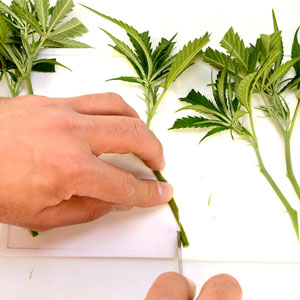
In botany, cutting, also known as division, is a plant division originating from an original plant stem, leaf or root and able to grow into a new plant without being disturbed. The cutting usually takes place in moist, warm soil. Many perennials, particularly tropical plants, are propagated via cutting; the method used varies by plant, however, and some plants, like ferns, which can only grow after pruning, are never propagated through cutting.
A cutting, in botany, is a division of a plant that occurs when a part of the plant's development is inhibited. Cuttings are sometimes used to provide a single plant with all its necessary parts. Examples include grafting or inter-plant grafting. In some cases, however, cutting is performed for other reasons than propagating.
Cutting promotes plant growth by removing leaves and stems and reducing root size. The cut edges then grow together, forming a trunk or stem. When the cut is complete, the plant's roots are removed and the plant forms new shoots.
The process of cutting a plant often depends on the type of plant and the location where it is cut. When pruning a tree, the cutting must be done at the base of the tree to prevent damage to the plant below the ground; when pruning shrubs, the cutting must be done above the soil surface or to a trellis or support; and when pruning a vine, the cutting must be made deep inside the vine, either at the base or a trellis or support.
Before cutting a plant, you need to know about the plant in order to know how to cut it. Some plants grow upright; others grow against the direction of the wind; and still others grow downward toward the sun.
Most plants, even woody ones, are best cut at the base of the stem or leaves, but some, such as ferns and vines, should be cut at the tip of the shoot. This ensures that the cut is deep enough to reach the center of the stem. If the stem is long and thin, the cut stalk will have a good view of the entire plant.

The best place to cut is in the center of the plant if it has a hard stem or leaves. When the cut is shallow, the cut can be made between the edges of the sheet, either by hand or with small scissors. After cutting a leaf or stem, rinse the cut with water and leave it on for a while before putting it back in place. Do not wash cut edges too much, otherwise you will wash out the roots.
When clipping, be sure to carefully check which part of the plant you are clipping
The cut should always be no deeper than the tip of the plant so that you can easily reach the roots of the plant if they grow underground. Also, be sure to leave some space around the cut in case the cut becomes infected.
When pruning the vine, be careful not to cut too deep or too short to avoid damaging or destroying the roots. If the stalk is too long, the vine can grow and take root in a different direction, instead of being cut in two different directions. If the stalk is too short, it will not allow air to circulate and will cause air circulation problems around the plant.
When cutting a plant, the cutting should not be done so deep that the leaves are cut or the plant has no air circulation. If the cutting is too shallow, the cutting will kill the plant. Also, remember that a cutting should be made so the plant is not damaged.
You should also check the soil before and after the cutting to make sure that there are no weeds or grass roots growing. The cutting is necessary after a plant has been planted, so it is important that you take care of the soil first.
There are several options available for cutting a plant. The most common way is to cut it from the base of the stem, which is usually done in the spring and early summer. This method is easy to accomplish because of the abundance of plant shoots.